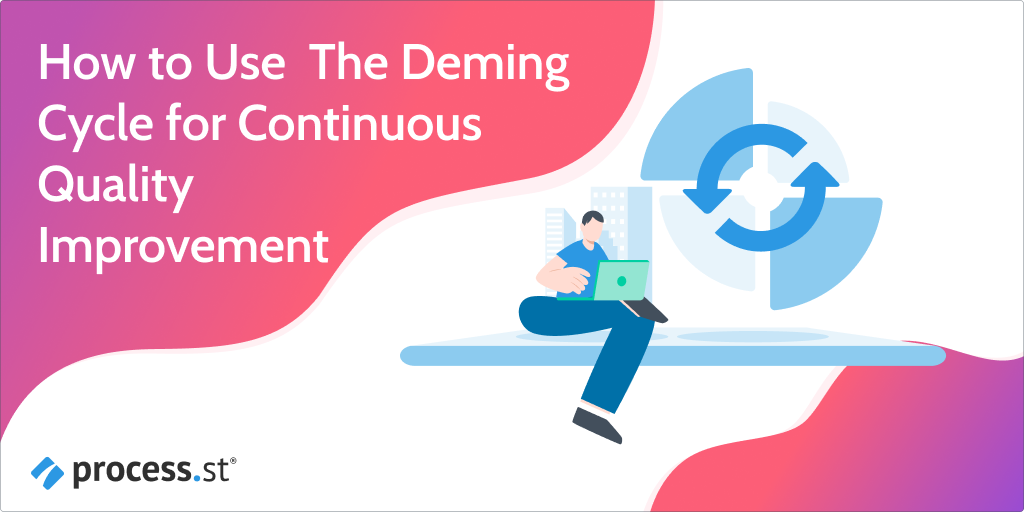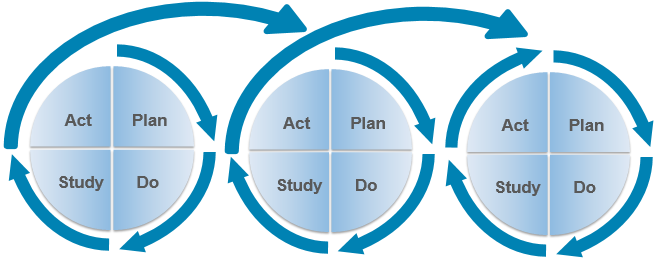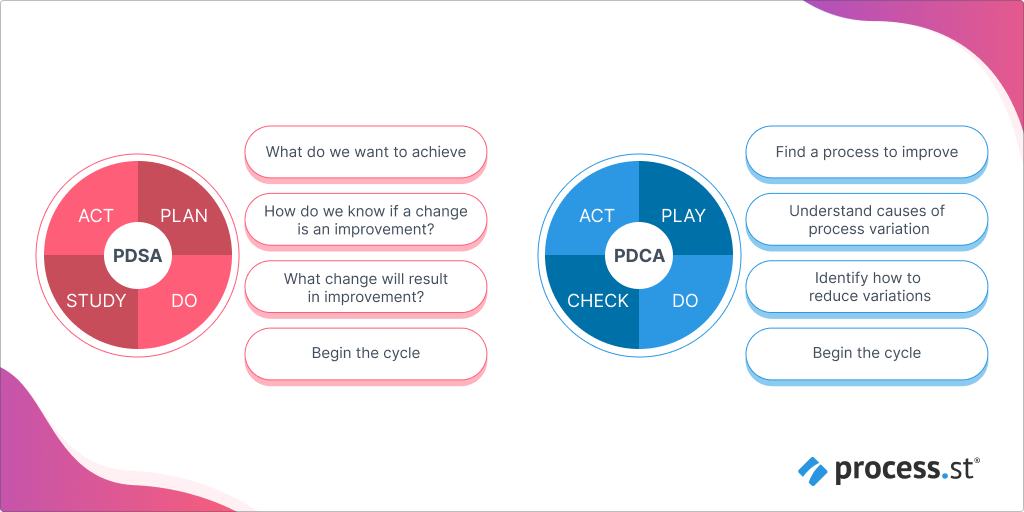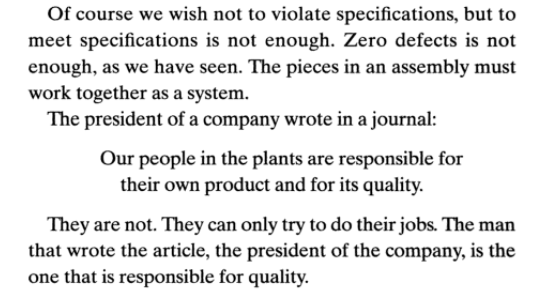
Understanding quality and seeking to improve it is arguably the core purpose behind undertaking process improvements. Hence the creation of the Deming cycle.
But where did this philosophy of process improvement come from?
One key person is William Edwards Deming – sometimes referred to as Edward W. Deming. He’s principally a statistician, but one could even call him a philosopher of science.
Deming’s goal was to reapply the scientific method to business processes, and has left us with two main variants of his thinking: PDSA and PDCA.
In this article we’ll outline:
- What the Deming cycle is, with its history
- How to apply the Deming cycle to improve your business processes
- The important distinction between PDSA and PDCA
- How PDSA is employed in the medical field
Deming’s approach is not just about improving processes, but about improving a whole business.
In a recent meta-study from the British Medical Journal, researchers found only 2 out of 73 studies had applied PDSA in a way which fully met criteria. Commenting:
To progress the development of the science of improvement, a greater understanding of the use of improvement methods, including PDSA, is essential to draw reliable conclusions about their effectiveness.
And that’s why we’re writing this article!
What the Deming cycle is, with its history

(Source)
The Deming cycle is a continuous quality improvement model which consists of a logical sequence of four key stages: Plan, Do, Study, and Act.
In the 1920s, the prominent statistician Walter A. Shewhart introduced a model consisting of Plan, Do, See – which can be considered one of the most important early-stage process improvement perspectives. Deming saw his own cycle as being the natural continuation of this model.
Deming’s experience training as an engineer gave him an insight into industrial processes and the material reality of trying to standardize operations to function at scale. He later studied mathematical physics which placed him in a strong position to contribute to the growing science of statistics. Deming’s sampling techniques, for instance, are still in use by the U.S. Department of the Census and the Bureau of Labor Statistics.
One of the great successes of Deming’s work could arguably be seen as his influence on the Japanese post-war economic miracle; where Japan’s economy recovered from wartime damage to assert itself as the second biggest economy in the world.
In 1950 he delivered a speech to the Hakone Convention Centre in Tokyo on his concept of Statistical Product Quality Administration. The themes of this speech are ones we’ll explore throughout this article, specifically:
- Having a system in place for continuous quality improvement
- Reducing defects through higher levels of quality uniformity
- Understanding what quality should mean within context
Deming’s work expands further into concepts of trade and governance, but we’ll focus primarily on process improvement. If you want to read more of Deming’s perspectives first hand, you can access his text The New Economics on Google Scholar now with the introductory sections open to access.
How to apply the Deming cycle to improve your business processes
As we’ve established, the Deming cycle is a four-stage approach to continuous improvement. This section describes each of the four stages, and explains how you can implement each stage into your business to continuously improve quality and processes.
Plan
- Understand your definition of quality
- How do you know if a change is an improvement?
- Can you predict your outcomes?
The first goal within the Deming cycle is to plan ahead to understand what you want to achieve. This is both a practical and theoretical step.
On the one hand, you are not dealing with scientific discovery, you are dealing with business processes. So you have a clear intention of improving something within the business, be it operational or concerning the product. This is guiding your end goal throughout the investigation.
On the other, you are also testing your own predictive and analytical methods. To what extent can you diagnose your existing problems? How well can you estimate your attainment? What problems will occur which you can highlight in advance?
The planning stage is both an attempt to improve your outcomes and a scientific investigation of your own capacity to understand your business.
In this stage you will want to test and analyze for what is currently wrong with the product or how it can be improved. You will also attempt to understand what changes you can make to tackle these problems or to make something better. You will look to map out operationally how this improvement can be managed and achieved. Finally, you will hope to be able to predict the outcomes of your process improvement efforts.
Do
- Start with small scale testing
- Implement iterative changes to your experiments to test variables
- Document every step
In executing the plan, Deming would continue to reiterate the importance of remaining true to the scientific values underlying the investigation.
Instead of simply deciding to make a change and suddenly overhauling all operations, it is vital to bring change about slowly and iteratively while testing hypotheses. Using studies which can be measured against control groups helps you better understand the data you receive, allowing you to not just improve your output but to understand exactly why your output was improved by the changes you enacted.
For Deming, you should carry out the implementation as if it were a scientific experiment.
Study
- Did your outcomes match with your predictions?
- In what ways did the outcomes differ and why?
- How could you test variables which were previously unaccounted for?
The study stage is the key point of differentiation from the PDCA cycle. For Deming, the outcomes of the planning and implementation will be shown in this stage. However, the outcomes are bigger than simply whether the process improved or not. The outcomes include whether or not the process improved for the reasons you thought it would improve. They would also include whether you were able to predict the changed outcomes in advance.
The study stage, for Deming, teaches us to draw conclusions like a scientist does, instead of simply asking if it worked. The question for Deming is not “Did it work?” but “Why did it work?”.
We can see this ethos in the following quote from The Deming Institute:
Dr. Deming emphasized the PDSA Cycle, not the PDCA Cycle, with a third step emphasis on Study (S), not Check (C). Dr. Deming found that the focus on Check is more about the implementation of a change, with success or failure. His focus was on predicting the results of an improvement effort, studying the actual results, and comparing them to possibly revise the theory. He stressed that the need to develop new knowledge, from learning, is always guided by a theory. By comparison, the Check phase of the PDCA cycle focuses on the success or failure of a Plan, followed by needed corrections to the Plan in the event of failure.
Act
- Implement your recommended changes
- Track performance and data over time
- Provide all documentation to the company to improve internal theory
The Act stage is both the final stage of our process and the first stage of our next cycle.
On a practical level, the Act stage may result in the practices of one of the controlled studies being implemented across business operations. Now that we’ve learned that output can be raised by doing action x, we want to do action x in each relevant department.
The Act stage is both the implementation of improvements into the company and the implementation of new knowledge into our theory of our own company. The Act stage should attempt to synthesize the new information gleaned in the Study stage with our broader understanding of how our business operates.
Much like the results of repeated experiments create new knowledge useful for both the conditions of those experiments and the body of scientific knowledge as a whole, so too must your results be incorporated into new premises from which you can begin the cycle again fresh.

(Source)
Now we’ve covered each of the four Deming cycle stages and we’re familiar with the concept, I can show you a PDCA change management template, that the team at Process Street have created, to help you with the following:
- Start a new improvement project
- Develop a new or improved design of a process, product, or service
- Define a repetitive work process
- Plan data collection and analysis in order to verify and prioritize problems or root causes
- Implement changes
- Work towards continuous improvement
To get this template, click on the link below, add it to your account, and follow the instructions. If you’re not yet a Process Street user, you can sign up for a free trial; it takes 5 seconds.
Click here to access the PDCA Cycle Change Management Model Process Checklist
The important distinction between PDSA and PDCA
We’ve already covered a little bit some of the elements which separate PDSA and PDCA.
On the surface, the difference seems to be the inclusion of the Study stage against the Check stage. It looks like a small difference. Yet, to Deming, that difference runs much deeper.
The following is a short extract from an excellent paper titled Circling Back by Moen and Norman:
On Nov. 17, 1990, Deming wrote a letter to Ronald D. Moen to comment on the manuscript for Improving Quality Through Planned Experimentation, coauthored by Moen, Thomas R. Nolan, and Lloyd P. Provost. “Be sure to call it PDSA, not the corruption PDCA,” Deming wrote in the letter.
For Deming, PDCA is about treating your process experiments as hypothesis testing – did it work or did it not work? Was the hypothesis true or the alternative true?
You can read more about hypothesis testing in my recent article: DMAIC: The Complete Guide to Lean Six Sigma in 5 Key Steps
PDCA concerns itself, in Deming’s eyes, as being about process improvement through defect reduction; through a focus on the mechanics of the process itself.

Deming doesn’t see anything wrong with this when used correctly, but it doesn’t jive with his overall philosophy on what process improvement is. Deming’s goal was to reinterpret Bacon’s scientific method for practical use in the improvement of business processes. In Deming’s eyes, this discussion cuts to the heart of the philosophy of science.
One of the great successes of Bacon’s theory of the scientific method, and one elucidated in greater depth by Immanuel Kant, was the way in which it tied together two competing approaches to how humans can find truth. These two epistemological approaches – simplified – argued between testing things in the material world through observation and experiment, and utilizing tools like logic and math to uncover truths.
The great success of science came from philosophers tying these two approaches together and creating a robust multipurpose method of inquiry that has driven human knowledge and innovation.
For Deming, PDSA sought to construct theory. From theory, we can learn more about our businesses and how they exist, in doing so we will be able to improve them and adapt them. We undertake experiments to both test and inform our theory, constructing our knowledge of our company the way we would construct complex scientific theory.
Deming sees PDCA as lacking that scientific rigor and that element of theory – he sees it being too concerned with hypothesis testing and other simplified means of investigation.
The key issue here is quality. Deming is quite damning of the claims that quality is the responsibility of the individual operating in a process, instead, believing that quality lies in the hands of the company president. The reason being is that Deming pushes for quality to be the primary mover within a grand theory of business – how a business should run, operate, design, and produce.
As such, quality defined as zero defects – as seen through the eyes of PDCA or Six Sigma – lacks a theory of being.
Deming wants to reinforce the importance of that theory of quality throughout all stages of a process.
If we look to his text, The New Economics, we see countless examples where he illustrates this:
[On cars] Performance and style, whatever these words mean in the minds of the customers, must show constant signs of improvement. Zero defects is not sufficient.
In another section, he discusses attending a conference and listening to 10 different presentations of reports from teams about reducing defects. He describes an audience of 150, listening intently, wanting to learn and improve. He comments:
They did not understand, I think, that their efforts could be in time eminently successful – no defects – while their company declines.
Deming illustrates his theory of quality by addressing a company president’s comments on where quality comes from and whose responsibility it is to ensure it, seen in this image below:

One way to think about the theory is to play on Deming’s focus on car manufacturers.
If we look at Ford, who is no doubt still performing admirably, we see a company with massive industrial clout and incredibly efficient production processes; Ford is almost certainly manufacturing at six sigmas. Yet, despite all this, Tesla has the higher market cap and appear, in the minds of the public, to be the future of cars.
Simply reducing defects in processes does not necessarily result in game-changing innovation.
The idea of keeping quality, central to the process improvement methodology, is what Deming sees as the differentiator between his PDSA process and the more granular and narrow PDCA.
Here are three more Process Street templates that you can use to improve quality by continuously improving.
FMEA Template: Failure Mode and Effects Analysis
Use this template to identify individual problems, or failures, which can occur within a process. Then, find the causes of these problems and failures and prioritize them in order of importance. Once prioritized, these problems can be tackled and the process optimized.
Click here to access the FMEA Template: Failure Mode and Effects Analysis!
SWOT Analysis Template
Use this template to analyze your organization, project, or process using four attributes (Strengths, Weaknesses, Opportunities & Threats) to determine a strategy for improvement or optimization. It’s useful for assessing risks and potential rewards while also understanding the most important factors that impact the success (or failure) of the business, project, or process.
Click here to access the SWOT Analysis Template!
McKinsey 7-S Model Process Checklist
Use this template to highlight the weaknesses in your organization and the areas that require the most improvement. The template encourages you to analyze the following 7 aspects of your company, and detail how each aspect impacts one another:
- Strategy
- Structure
- Systems
- Shared values
- Style
- Staff
- Skills
Click here to access the McKinsey 7-S Model Checklist Process!
How PDSA is employed in the medical field

(Source)
As we outlined in the introduction, PDSA is routinely poorly or misapplied within the medical field with the BMJ paper stating:
Using these criteria to assess peer-reviewed publications of PDSA cycles demonstrates an inconsistent approach to the application and reporting of PDSA cycles and a lack of adherence to key principals of the method. Only 2/73 articles demonstrated compliance with criteria in all five principles.
The two papers which passed the test, in case you want to read them, were:
- Lynch-Jordan AM, Kashikar-Zuck S, Crosby LE, et al. Applying quality improvement methods to implement a measurement system for chronic pain-related disability. J Pediatr Psychol 2010;35:32–41. Free access here.
- Varkey P, Sathananthan A, Scheifer A, et al. Using quality-improvement techniques to enhance patient education and counselling of diagnosis and management. Qual Prim Care 2009;17:205–13. Free access here.
So what 5 criteria did the BMJ researchers decide was necessary to be fulfilled to consider PDSA properly applied?
Let’s investigate!
Mirroring the scientific method
…formulating a hypothesis, collecting data to test this hypothesis, analysing and interpreting the results and making inferences to iterate the hypothesis.
The most basic principle for the researchers is that the studies they are analyzing are clearly following the core elements of the scientific method. Simple enough.
Starting with small scale tests
The pragmatic principles of PDSA cycles promote the use of a small-scale, iterative approach to test interventions, as this enables rapid assessment and provides flexibility to adapt the change according to feedback to ensure fit-for-purpose solutions are developed.
The authors are quick to note added benefits of small scale testing including:
- Freedom for researchers to act and learn
- Minimizing risk to patients
- Minimizing the levels of organization and resources required
- Providing opportunity to engage stakeholders early in the process
Predicting your outcomes
In line with the scientific experimental method, the PDSA cycle promotes prediction of the outcome of a test of change…
This requires strong knowledge of what you’re seeking to do and how it will work in the context of a complex scenario with multiple variables. The stronger the theory, the better these variables can be accounted for. Being able to predict outcomes in advance is a greater validator of your theory than whether the experiment worked or not.
Measuring your data over time
In recognition of working in complex settings with inherent variability, measurement of data over time helps understand natural variation in a system, increase awareness of other factors influencing processes or outcomes, and understand the impact of an intervention.
Continued testing over time helps reveal a greater number of variables which can have an effect on outcomes. Deming, in The New Economics, discusses designing a car door: the weight of the door must be perfected, but it must be exposed to windy days, rainy days, and wear and tear before you know whether it is right.
Documenting your processes and findings
As with all scientific methods, documentation of each stage of the PDSA cycle is important to support scientific quality, local learning and reflection and to ensure knowledge is captured to support organizational memory and transferability of learning to other settings.
If Deming’s approach is about building a total theory of your business to operate from, then it makes no sense to not document your activities. Every finding is a data point, not just whether the experiment worked or not. Without all the data points, the theory which drives your business forward will not be the best it can be.
Don’t just optimize a process, improve it!

(Source)
Deming’s approach appears to want us to take the blinkers off.
Stop looking narrowly at only small tweaks to remove inefficiencies in processes and start thinking big about how your processes can be improved to increase quality – in whatever capacity that exists.
To help you with this, and define the process you want to optimize, measure how it currently performs, analyze how it can be optimized, decide how to improve it, implement the new process and create a plan to measure it and review it again in future, feel free to use this Process for Optimizing a Process:
Click here to access The Process for Optimizing a Process
I’ve mentioned Process Street a few times during this post, and I’ve given you five great Process Street improvement method templates that you can take away and use to your heart’s content, but you might be wondering who exactly is Process Street?
Who is Process Street?
Process Street is super-powered checklists. It’s state-of-the-art business process management (BPM) software that specializes in making recurring work fun, fast, and faultless for teams everywhere.
Take a look at this introductory video, or read this help article, to find out a little more about who Process Street is:
As you can see, with Process Street you can create a process for anything and everything; from onboarding a new employee to writing your daily to-do list.
Choose a process, build a template for the chosen process, or use one of our many pre-made templates (like the ones I’ve given you in this post), and each time you need to go through this process, run an individual checklist from that template. Checklists can be as simple or as detailed as you like.
Create intuitive and helpful tasks using these features:
- Stop tasks
- Dynamic due dates
- Task permissions
- Conditional logic
- Approval tasks
- Embed widget
- Role assignments
Or, connect to thousands of apps via Zapier, webhooks, or API integration to automate as much of your process as possible and make life easier.
Watch this webinar for more information on how to truly automate your processes:
If you want to read around the subject of process improvement, take a look at these related articles
Process improvement related articles
- Process Improvements: Your Ultimate Toolkit With 17 Free Templates
- Process Improvement: Stop Bad Processes Killing Your Business
- Pinch Analysis: Process Improvement Tips From Thermodynamics, Cars, and Cooking
- Agile ISO: How to Combine Compliance with Rapid Process Improvement
- Guide to Process Improvement
- Making Creative Workflow Improvements
- The 24 Best Business Process Management Platforms for 2019
- The Basic Business Processes and Business Process Management
So, to conclude this post; according to Deming, we should be using the same levels of scientific rigor that would expect from top researchers. We should be building to a grand theory of quality within our own business and tailoring each process to serve its part in meeting those needs.
Deming is one of the grandfathers of process management and quality improvement but, as the BMJ study shows, we need to be re-educated on his ideas now as much as ever.
Have you used PDSA in your business? Have you read The New Economics? Let me know your thoughts and experiences in the comments below!







Adam Henshall
I manage the content for Process Street and dabble in other projects inc language exchange app Idyoma on the side. Living in Sevilla in the south of Spain, my current hobby is learning Spanish! @adam_h_h on Twitter. Subscribe to my email newsletter here on Substack: Trust The Process. Or come join the conversation on Reddit at r/ProcessManagement.